プロデュース部 部長、 Food Hub Project 支配人の真鍋です。
食堂「かま屋」と「かまパン&ストア」がグランドオープンして1ヶ月半が経ちました。おかげさまで連日たくさんの方にお越しいただいています。なかでも「かまパン」のパンは人気ですが、一方で、フードハブになぜ「パン屋」が必要だったのか?と聞かれることも増えてきました。
「地産地食」を掲げる私たちが、どういう考えでパン屋をやっているのか。
フードハブにとって、パン屋とはどういう位置づけなのか。
あまり美味しそうな語り口ではないので、つくり手たちからすると微妙かもしれませんが(汗)、今回は「パン」と「地域」と、「経済」と「循環」について書いてみようと思います。
「パン屋」だけど「パン」だけじゃない話。
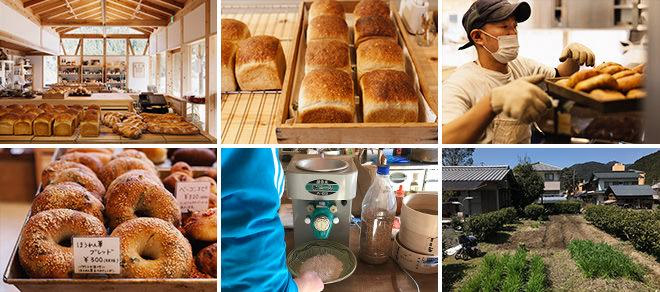
フードハブ・プロジェクトは、神山町の創生戦略を考えるワーキンググループから生まれています。フードハブを、地域内で経済を循環させ、神山の農業を次につないでいくための「装置(Operating Sysytem)」ととらえた時、どういった「機能群(Applications)」をフードハブに実装していけば良いのか、そんな感じのことを考えていました。
フードハブというOSにおいて、「パン屋」は中核となるアプリケーションのひとつです。
その視点から「パン屋」を見た時に、いくつかの要素に分解することができます。
- 「パンを売る場所」:日常と非日常に機能する集客装置
- 「パンという商品」:「すっぱい」から関係性を育てる媒介者
-
「パンとつくり手」:つくり手と地域の自家培養発酵種
これらの3つのモノゴトがそのアプリには実装されていることになります。
1.「パンを売る場所」:日常と非日常に機能する集客装置
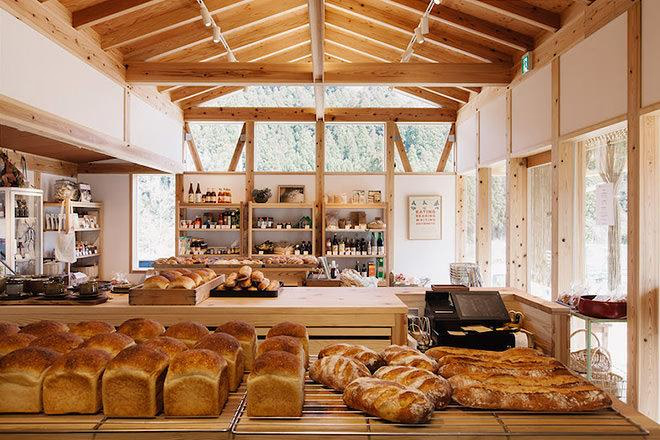
農業の会社として、私たちが飲食店を通じて目指しているのは「神山の農業を食べて支える」という意識を日常的に持ってもらうことです。食べる人を「消費者」として扱わず、町に一緒に暮らす「生活者」として捉え、「農業を食べて支える」という考え方を地域の幅広い年齢層のみなさんに理解してもらう。そしてフードハブが飲食店や加工品開発を通して収益をあげることで、地域内で経済を循環させ、神山で新規就農者を増やしていく、ということです。
で、なぜパン屋なのか。
昨今の日本で、良い悪いを抜きにして、老若男女、パンが嫌いな人っているんだろうかと思います。◯◯パン祭りのように、たくさんの人たちを集客するイベントが各地であったり、何時間もかけて美味しいパンを買いに行く人も多いと聞きます。
神山町にも「まきパン」という素敵なパン屋さんが数年前までありました(現在は休業中)。そこには、町外からのお客さんが連日朝から並び、午前中には売り切れてしまうという状態でした。また、地元の人たちも予約して買ったり、お土産によく買っていたと聞きます。(徳島の人は、パンをおもたせにするそう)
「これは…パン屋をやったら、また人来るな...。」
フードハブを企画している時に、こんな野蛮な発想が最初にポッと頭の中に浮かんだのは、
否定できない事実です...。
一応、更に思考をめぐらせ
「パンだったら、幅広い世代の人(老若男女)が食べられるし、
週に何度も店に来てくれるかもしれない(日常性が高い)」
「定期的にやっているパン屋が町にはないので、地域内でお金も循環する」
実際に私たちも、市内まで天然酵母のパンを定期的に買いに行っていました。
都心とは違うロジックだと思うのですが、神山のように、市内にわざわざパンを買いに行く、また市内からもわざわざ買いに来るという土地柄を考えると、フードハブにパン屋を組み込むことで、地域の人に対しては、日常的に使ってもらう場所になり(来店頻度高)、更には、より広い範囲で人を集客(商圏範囲を拡張)することができるのではと考えました。そういった意味で、非日常と日常の両方に集客装置として機能することができるのが、フードハブ、そして神山という立地での、パン屋という場所です。
でも、どこにでもある普通のパン屋をやってもそうはいきません。
2.「パンという商品」:「すっぱい」から関係性を育てる媒介者
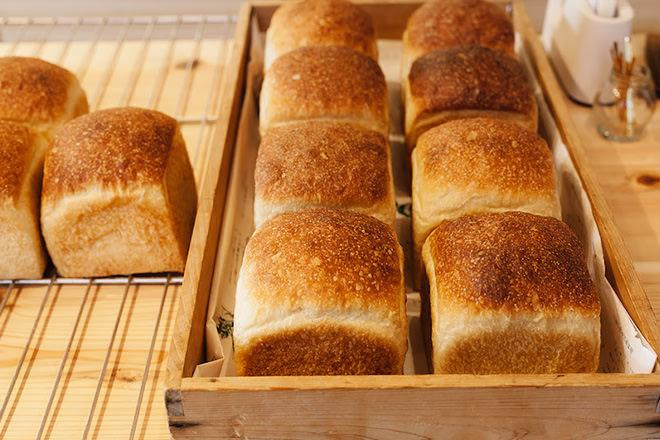
フードハブ・プロジェクトがやるべき「パン屋」とはどういうものか。
料理長の細井と時間をかけて話し合い、自分たちが焼きたいパンではなく「地域のパン」を目指してやろうということになりました。
二人のつくり手が、「地域のパン」を作ることをめざし、切磋琢磨しながら、酵母を育て、朝早くから、毎日たくさんのパンを焼いています。
その中でも、中心に据えたのが、「食パン」。
農業も食堂も、お米を基本にしているフードハブですが、「食パン」も大切にしています。
今や、日本の家庭ではなくてはならない主食のひとつなのに、スーパーに並んでいる食パンは、安定して大量生産するために、乳化剤やイーストフードなどの食品添加物が含まれているのが現状です。(なので、それらの価格はとても安い)
「つくり手」が本気で作った食パンが、町の人に評価してもらえるのか。
大量生産の食パンと比較してもらおう。
そんな気持ちで、あえて王道である「食パン」を核に据えています。
かまパンでは、自家培養発酵種という酵母や乳酸菌の集まりの種を自分たちで育て、全ての生地に入れています。食パンは、 小麦粉、牛乳、砂糖、レーズン液種(これも発酵種のひとつ)、自家培養発酵種、塩でつくられています。あえて生地にバターなどは入れずシンプルに仕上げ、分厚く切って焼いてそのまま食べても美味しいけど、バターをつけたり、季節のジャムを塗るなど変化も楽しめるシンプルなものになっています。
私たちの食パンの特徴を「物感」「価格」「味」でお伝えしたいと思います。
物感:ずっしり、もっちり。
かまパンの食パンは、持っただけで「普通とちがう...」というのがわかります。
「重い」んです。
パン酵母(一般的にイーストと言われている物)の代わりに自家培養発酵種を使用し、香川のうどん粉(中力粉)を使用しているため、一斤あたりの生地量がとても多くなります。その結果、あまり膨らまずギュッとつまっていて、もっちりしています。(原価が!)
開発を担当した、天然酵母のパンの老舗 ルヴァンの元製造責任者の塩見くんは、
- 毎日、ごはんみたいに食べられる。
-
そして、しっかりとお腹にもたまる食べ応えのある食パン
を目指して開発してくれました。先述の自家培養発酵種のおかげで、そのしっとり感は、数日たった後も続きます。(食べたくなってきました?)
価格:300円(税抜き)
通常スーパーなどで売っている食パンは、一斤180円くらいで、100円を切るものもあるようです。(食パンにいくらだせますか?というスレッドが面白い)
私たちは食パンを300円で販売しています。私たちの考える「地域のパン」の核として食パンを位置づけるのであれば、価格も日常じゃないとだめだと話し合い、この価格に落ち着きました。
理想の食べ方は、一斤を「分厚く」4枚に切って、表面をカリッと焼いて食べる。ぎゅっと詰まっているので、大人なら一枚、子供ならその半分でも十分だと思います。よって、4人家族で、かまパンで売っているたむらのタマゴ(38円/個)を茹でて、1人朝食120円くらいの計算になります。
人によっては高いと感じるかもしれませんが、天然酵母などの自然なものをつかい、粉にもこだわり、つくり手が毎朝焼くことを考えると、再生産可能なギリギリの価格だと思っています。
そのおかげか、地域の年配の方々にも「食パン高いけど、美味しいな」とお声がけいただき、リピートしてくださる方も本当に多くなってきました。地域のパンに向けて、第一歩を踏み出せているのではないかなと思っています。
味:たまに、すっぱい。
天然酵母を使用したパンは、通常、酸味が強いものが多いのですが、かまパンのつくり手たちは酸味を抑えつつも、その良さを残す工夫をしています。でも、自然なもので作っているので、季節の温度変化などによって、味のブレが生じてしまうことがあります。通常は、ほんのりとした酸味が、今日は「すっぱいなぁ」と感じることがあるようです。
そんな、食パンの味についてのお客さんとのやり取りを、かまパン&ストアの食育係からのレポートでお伝えしたいと思います。
夕方来られたお客様と「すっぱい」食パンの話をしました。
#十人十色のパンの味(彼女特有のハッシュタグ)
「年寄りは何も味せん食パン食べ慣れとるけんな、このパン酸っぱい言うて(わたしはわかるけどな、と言いながら)。噂はこわいでよー。わたしや(パン好きな人)は、これ持ったらわかる。見てもわかる。他のとちゃう。一目瞭然。」
パンの説明資料を渡して話をすると、
「ほら、説明は必要やわー(うわさはこわいでよー)。年寄りにはわたしがこれ読んで説明しとく!」
酸っぱいことを酸っぱいと言ってるお年寄りと違って、「わたしはこの酸っぱさの良さがわかるのよ!」的な雰囲気が感じられて、お話するの楽しかったです。「また買いにくる、食パン買いに来る!」って帰られました。
ちなみに、この方のご主人は、他のパンと違って「何もつけなくても美味しいパン」と言って、バターもつけずにそのままを食べているそうです。昨日来られた方で「2日目の食パンは酸っぱすぎてわたしは無理!」って言った方に、今からでもパンの説明資料をお届けしたいです。
というような会話が、日々お店では繰り広げられています。
ここで大事なのが、私たちはなぜ、この「味が安定しない食パンをそのまま売っているのか」です。
大量に生産される食品の多くは、消費期限が過ぎても腐りにくかったり、カビにくくするために食品添加物を使って製造されます。それが製造者にも消費者にも「安心・安全」と捉えられることが多いように感じます。
口に入れると、口の中の水分を取られて、飲み物と一緒じゃないと食べづらいパンがありますよね。かまパンの食パンを含めて、天然酵母などで作られたパンは、ほのかな酸味が口に含むと感じられ、じわっと唾液が出てきて、その作用から、噛みしめると小麦の旨味がしっかり味わえるのではと思います。
自家培養発酵種など、自然なものと協力してパンをつくる場合、味がブレるのが普通。味を安定させるように、つくり手が努力もしていますが、それを「今日はこんな感じです」と、日々対話を繰り返すことで、食というモノゴトを通じて、失われつつあった「つくり手」と「食べる人」の関係性を、また育てていくことができるのではと私たちは考えています。
3.「パンとつくり手」:つくり手と地域の自家培養発酵種
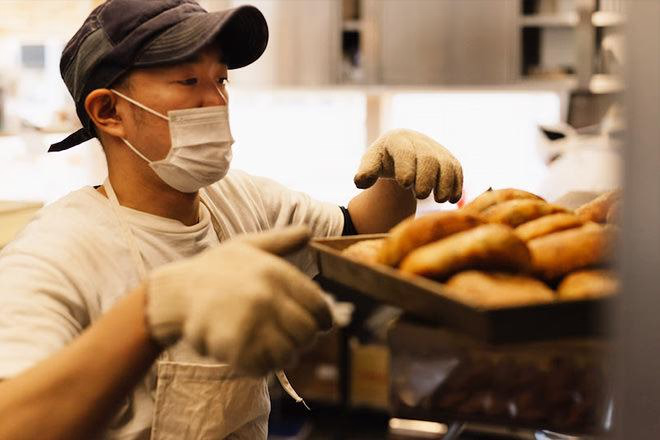
「1. パンを売る場所」から「2. パンという商品」と話を進めて来ましたが、私たちが運営する食堂の「かま屋」やパン屋の「かまパン&ストア」を切り盛りするのは、つくり手たちです。また、春夏で140品目以上の野菜を育てようとしている農業チームも同じです。
ちょっと話は飛びますが、先述の私たちのすべてのパンに入っている「自家培養発酵種」には、レーズンや小麦粉などの素材に加え、神山の空気中に生きる乳酸菌や酵母たちが入っています。その菌たちが共存する生態系(エコシステム)を「種」と呼び、それは、神山でしかできない、神山の味の“素”とも言えます。
パンづくりを通して、自家培養発酵種のように、地域をどんどん巻き込み発酵しつづける「つくり手」たちのエコシステムをどう育てていくのか。今、さまざまな取り組みを進めているところです。
季節パンがつなぐ、農業と地域。
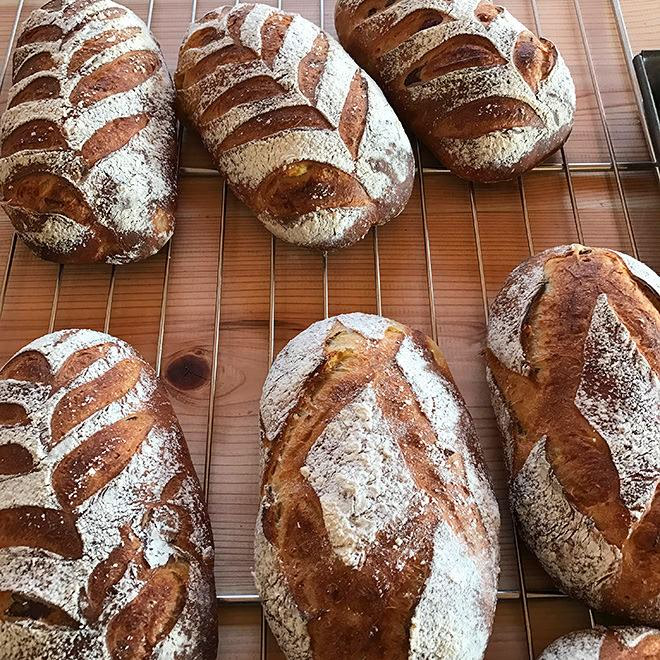
かまパン&ストアでの人気の商品のひとつに「季節パン」があります。
最近まで人気だったのが、「さつま芋ローフ」。自分たちで育てた、さつま芋をコッペパンの生地に練り込んで、ローフ状(長方形)に焼いています。これが、さつま芋の甘味と小麦の旨味がうまく混ざりあって美味しいのです。でも最近、自社のさつま芋が底をついたので、次に何を練り込むか、ということで、ニンジンで試すと、生地との相性や水分が多すぎて、べちゃとなって上手くいかなかったり...ということが続いていました。
試行錯誤している時に、地元の農家さんに相談すると、今の季節なら、「ヨモギがあるわ」と言ってくれ、更には、お店が大変だろうからと、湯がいて細かく刻んで納品してくれるという親切ぶり。そして、出来上がったパンを、農家さんたちが楽しみに買いに来てくれるという嬉しい循環。そんなやり取りを経て「よもぎローフ」が完成しました。
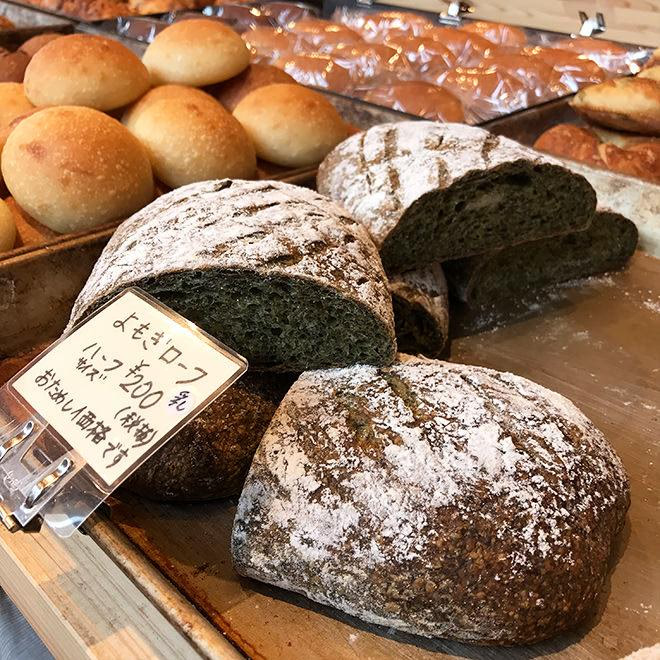
あんペーストを塗って食べると美味しそう。あんパンの餡子でペーストつくろうかとも話しています。
また、米粉入りバゲットの生地を使って、季節の葉物野菜を練り込んだパンもあります。季節ごとに「ほうれん草ブレッド」から「壬生菜ブレッドへ」と移り変わり、現在は、「クレソンブレッド」を販売しています。
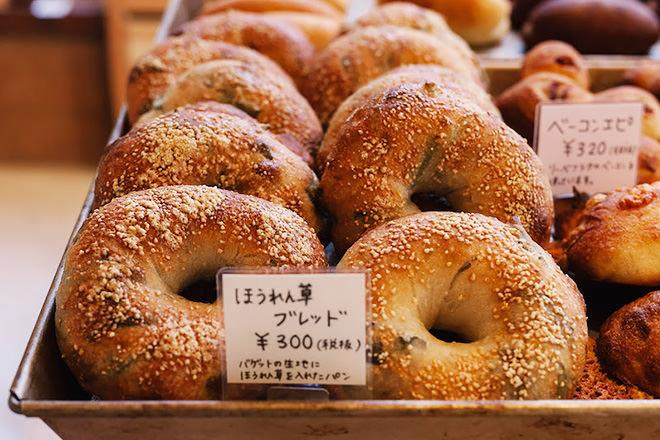
さらには「季節パン」から発展して、神山町にある農業高校の城西高校分校と連携して、高校生たちが育てる春夏の葉物野菜を練り込む、食育パン?も企画中です。
料理や加工品とは違った、パンそのものが持つ商品としてのパッケージ力と軽快さ。オープンで柔軟、かつ技量の高いパンのつくり手たちがいるからこそですが、スピード感をもってどんどん農業や地域を巻き込んでいけるのも、パンとつくり手のなせる技ではないかと思っています。
カミヤマ カンパーニュ・プロジェクト(仮称)
みんなで育てた神山の小麦を使って
地域のパンをつくる?!
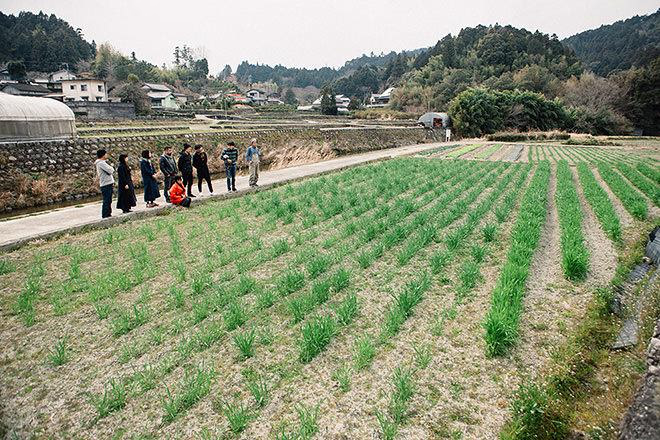
フードハブ農業長 白桃の実家には、70年以上受け継がれている「種」が色々あります。
餅米、大豆、小豆、小麦。他にも様々。
「餅米」は、「地元の小学生」たちと、田植えをし、草をとり、餅を食べ、その種を取って循環させる食育の授業に活用。「大豆」はこれから作付けをして「隣村の豆腐屋」さんと一緒に豆腐を作る予定。「小豆」は、「地元の和菓子屋」さんに炊いてもらっている、かまパンでも人気のあんパンの餡に使えないかとこれから作付け予定。とまだまだこれからのものばかりですが、農作物を育てるところから、地元の皆さんに食べてもらうまでを、地域の生産者の方々と一緒に取り組もうとしています。
その中でも小麦は、昨年の10月頃から、神山で受け継がれてきた種を含めて実験的にいくつかの品種を作付けしています。やはり地域で受け継がれてきた種は強く、同時期に、同じ畑に、同じ条件で植えたのに成長度合いが全く違います。
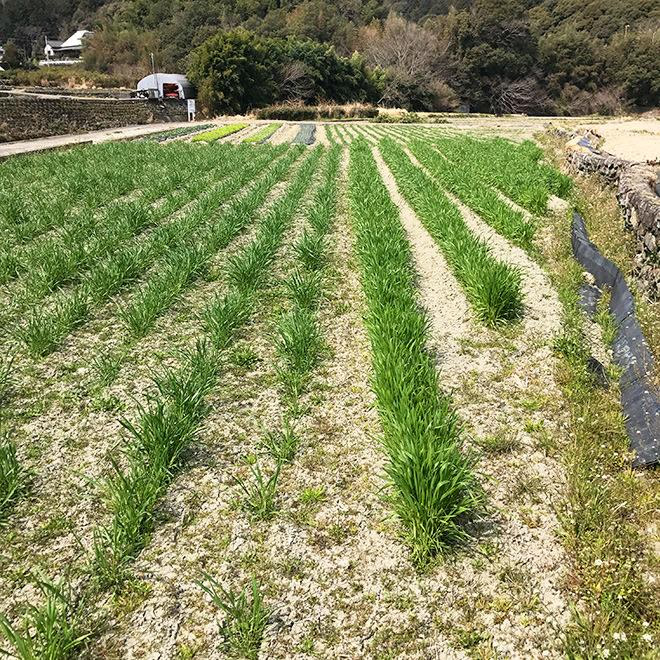
右が、神山に受け継がれてきた小麦で、左が別の品種の小麦
かまパンの商品開発担当の塩見くんが、その小麦をつかってパンをつくる実験もしてくれています。(その時、パンのような物は焼けましたとの報告を受けていますw)
現在のパンのラインナップは、歯切れが良い、いわゆる「やわらかい」パンが中心ですが、この受け継がれた小麦を使ったパンは、つくり手として徹底的にこだわり、ワインや食事にも合うハード系のカンパーニュにしようと話しています。
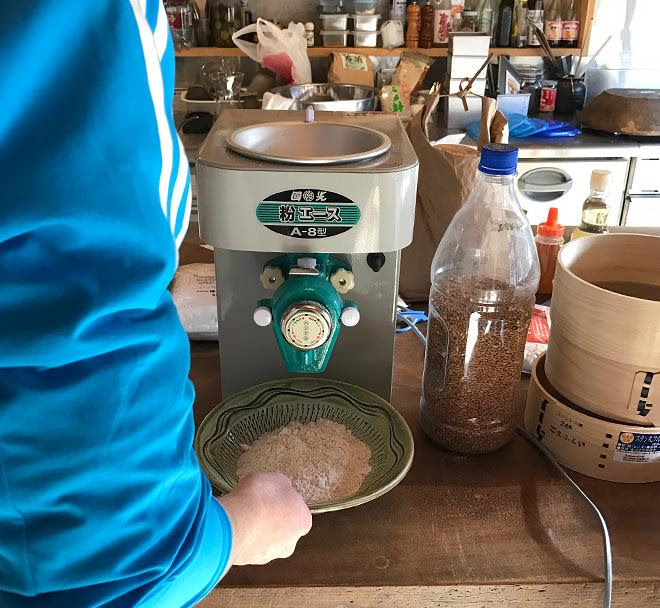
青いキャップのペットボトルに入っているのが、神山で受け継がれて来た小麦。実験的に製粉し、全粒粉で他の小麦粉と混ぜて焼くと「パンのような物は焼けます」とメニュー開発担当の塩見。
更に、地域を巻き込み、みんなを「つくり手」にするには(実験中)。
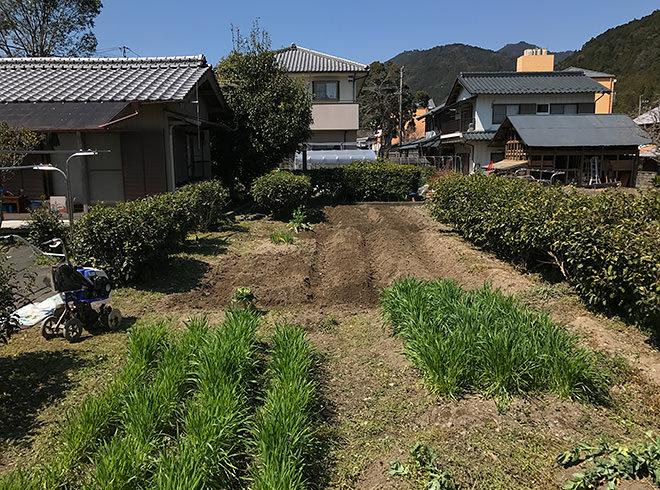
自宅の畑。神山で受け継がれる小麦を自分の畑でも育ている(手前)。
長くなりますが、もう一つだけ。
この神山で受け継がれてきた小麦の種を分けてもらって、昨年の秋から自宅の畑でも小麦を育てています。
その時は、ただ育ててみたいくらいにしか思っていなかったのですが、
この育てた小麦をフードハブに戻してパンにしてもらったら面白いかも。
自分もただ「消費」するだけじゃなくて、「生産者」にもなることができるな。
と後になって思ったのです。
神山は農地付きの家も多く、空いた畑を持っている人も多い。小麦は、農作物の中では比較的、育てるのは楽。でも、収穫→乾燥→脱穀→製粉と、食べられるようにするまでが結構大変。それなら、みんなに種を配って小麦を育ててもらい、収穫もしくは乾燥の段階からフードハブがある程度機械化することができれば、より多くの人が「つくり手」となり、「地域のパン」づくりに関わっていけるのでは、と話し合っています。
10月からほぼほったらかしで、勝手に育っている自宅の畑の小麦が、上手く収穫できるかどうかはまだ分かりません。また実際の小麦の買取価格、再生産の可能性や、本当にこの小麦で美味しいカンパーニュが焼けるのか?など、課題は多くあるのは事実です。でも、より多くの人が、神山で「つくり手」となり地域のパンづくりに参加できるよう、みんなで話し合って進めていけたらと思っています。
最後に。
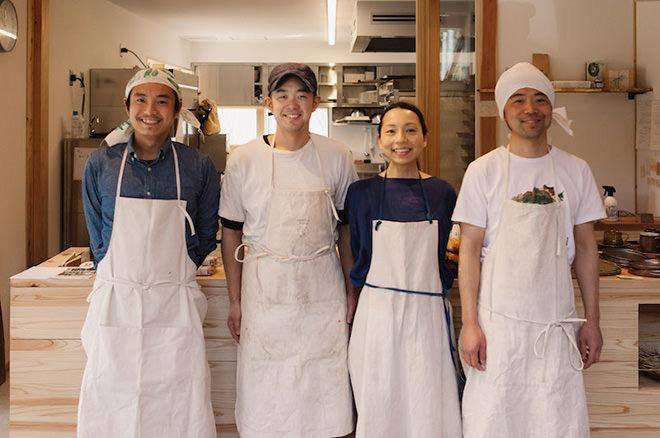
正直なところ、綿密に計画を立ててパン屋をはじめたわけではありません。成り行きと言えばなりゆきです。でも最初から決めていたのは、料理人やパン職人、農業の担い手の「つくり手」が中心となって地域と関係性をつくり、フードハブの活動を循環させて行くことです。
「パン」と「地域」と、「経済」と「循環」。
さあ、あなたも「つくり手」の一員となって、神山の味の“素”になってみませんか?
